
Peer reviewed journal - published through Research Catalogue, NMH portal
New music for old instruments
Helena Marinho and Joaquim Branco
University of Aveiro / INET-MD
CONTENTS
Evading literalness
Playing with their history
Childish toys
The whys and the hows
Expanding the fortepiano
Some concluding remarks
Evading literalness
back to top
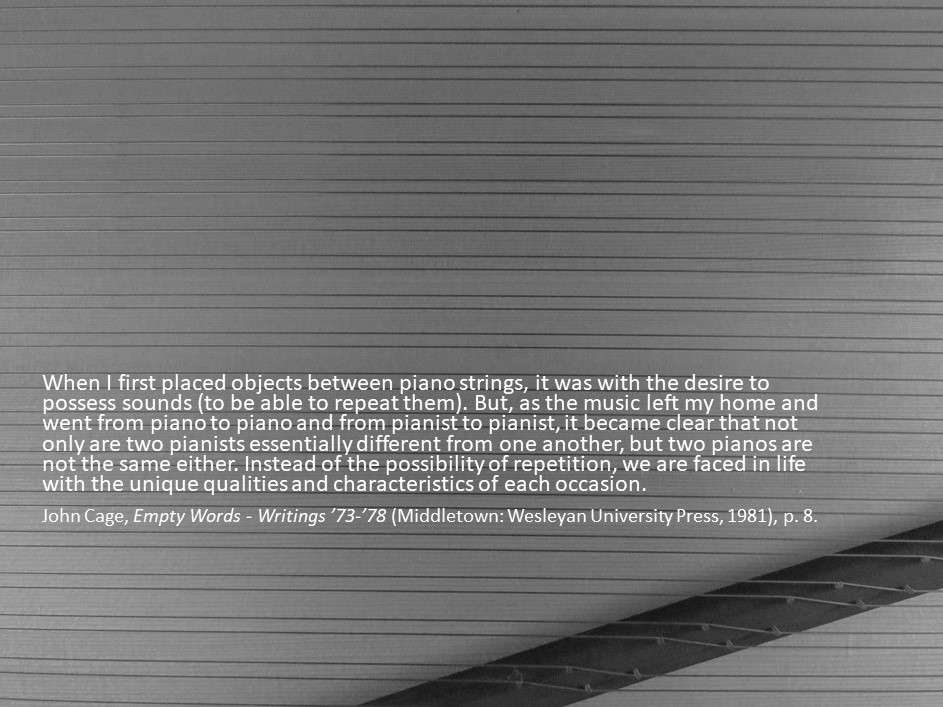
In the image above, Cage’s words are projected over the inside of my
[Helena’s] fortepiano, a copy of a 1805 Walter & Sohn, built by Paul
McNulty in 2004, with the so-called Viennese action and two knee-levers
(instead of pedals). Its sound is feeble when compared to a contemporary
grand piano - irritatingly metallic and clanging, some would say. But it
can achieve the softest and most beautiful of pianissimos, and its tone
colours are naturally uneven and expressive. It is a unique and
unrepeatable instrument, and probably the wrong medium for a pianist
particularly focused on performing new works. I [Helena] began playing
newly composed repertoire on this piano in 2008, and challenged several
composers to write solo and chamber works and develop an approach that
would explore its distinctive features. The composers who responded to
this challenge were: Jônatas Manzolli (Brazil), Evgueni Zoudilkine
(Russia), Sara Carvalho, António Chagas Rosa, Vasco Negreiros (Portugal)
and Daniel Schvetz (Argentina). Playing contemporary repertoire on a
historical instrument, and therefore being detached from the usual
anchors of historically-informed performance is initially liberating.
However, it can quickly become an overly literal matter of exploring the
instrument’s physical resistances and affordances in relation to what
the composer has asked for. This the report of a project that sought to
evade that literalness.
Playing with their history
back to top
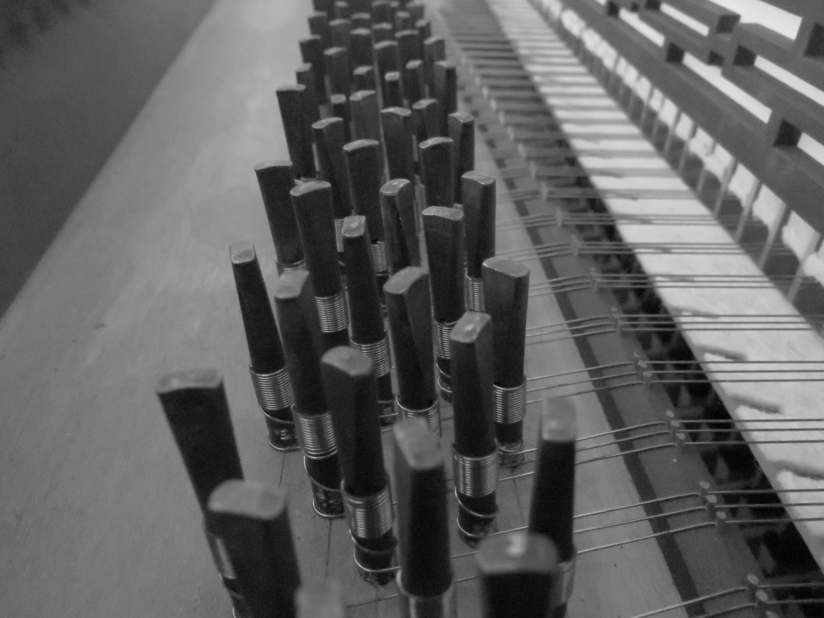
Historical keyboard instruments such as the harpsichord or the fortepiano are often associated with the performance of canonical period repertoire, which generally encompasses Renaissance and Baroque repertoire for the harpsichord, and Classical and early Romantic works for the fortepiano. Nonetheless, there is a significant and increasing corpus of 20th- and 21st-centuries works for these instruments, which explores their specific characteristics and instrumental / performing affordances. The harpsichord’s repertoire, for instance, comprises important 20th-century works such as Falla’s Concerto, Poulenc’s Concert champêtre, Ligeti’s Continuum, and Xenakis’ À l’île de Gorée.
The fortepiano has not attracted the same amount of attention, but some composers have occasionally contributed to this instrument’s repertoire, including the authors of the works commissioned by co-author Helena. In the case of the fortepiano, the restricted access to extant original instruments, and the fact that copies are often privately owned, among other limitations, may have hindered the development of a wider corpus.
Composing contemporary works for historical keyboard instruments is a challenging task, taking into account their complex history, the multiplicity of models available, and the fact that the mutations or effects added by stops or pedals introduce sonic affordances that may be applicable to one instrument but not to others. The fortepiano[1] raises specific issues, as it shifted from an acknowledged adherence to the sonic characteristics of the harpsichord, apparent in early 18th-century models, to the establishment of idiomatic piano timbre features, which, as the 19th century progressed, both followed and stimulated the onset of new composing trends and new venue contexts.
Nowadays, builders of fortepiano copies often follow standard designs of a few paradigmatic models, such as the late-18th/early-19th Viennese fortepianos by Stein or Walter or early 19th-century British designs by builders like Broadwood. These models of fortepianos featured devices, known as Veränderungen or stops, introduced during the mid-18th century,[2] which were used to alter the standard percussive sound produced by the hammers. Operated through hand knobs (in earlier models), knee-levers or pedals, they were equivalent to some of the effects produced by the pedals of the ‘modern’ piano. One of these effects, the sustaining stop, corresponds to the sustaining pedal of the ‘modern’ piano. Other common effects, such as the una corda or the moderator, display some timbral similarity to the una corda (in fact, due corde) of the ‘modern’ piano, but the sonic resemblance is partial. Stops that produce percussive or other more exotic timbre-altering effects, such as the Janissary or the bassoon, or models that include them, can also be found in several modern builders’ catalogues, and are included as added or specific features (at an additional cost).
Childish toys
back to top
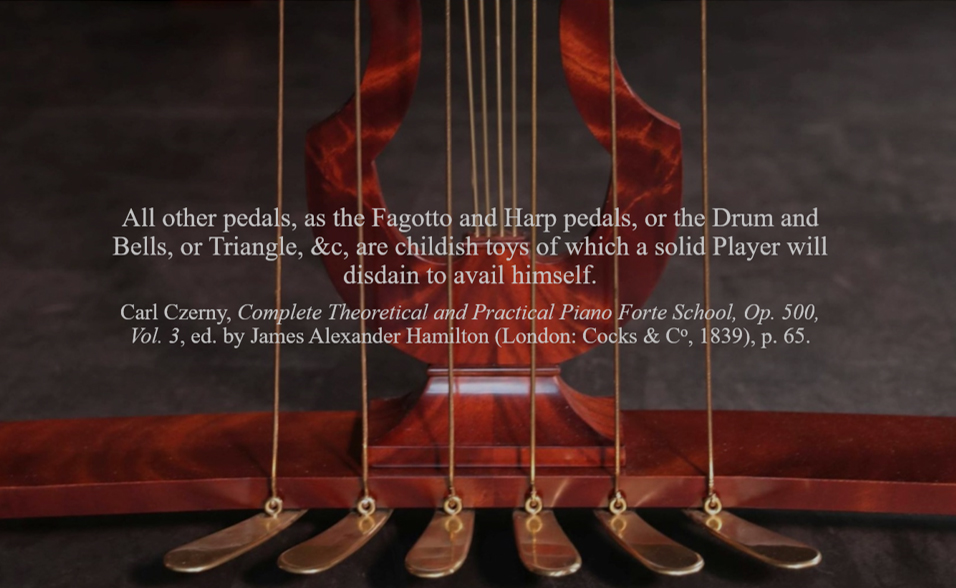
Copy of a Graf fortepiano from 1819, built by Paul McNulty, which features six different pedals: una corda, bassoon, single moderator, double moderator, sustaining, and the Janissary, which combines drum, bells and cymbal sounds.
A negative outlook toward some of the fortepiano’s striking timbre affordances became common in the early 19th century, as evidenced in Czerny’s description above, and led to the development of a sonic image of the fortepiano’s affordances that precluded these ‘childish toys’, notwithstanding their inclusion in more elaborate models of prestigious builders like Graf or Érard. This construction of a specific sonic image may also have conditioned, to a certain extent, subsequent views of these devices, especially of those that were not integrated into later designs as the staple pedals of ‘modern’ pianos, such as the sustaining and una corda pedals. Dieter Hildebrandt’s commentary, which implicitly compares the standard effects with the devices discarded after the mid-19th century, reflects this stance:
The pedal cannot be said to have become the soul of the piano until the second half of the nineteenth century, when all these exotic accoutrements fell away. The pianoforte had first to abandon the foreign frippery and concentrate on its own sound, its own increasingly full and powerful, metallic and abstract sound, a far more interesting field for experimental composition.[3]
Defining the piano’s ‘soul’ as related to the sustaining pedal, Hildebrandt denies the relevance of other effects, and defends the ‘abstract’ nature of the modern piano’s sound. The ‘foreign frippery’ that, according to him, was destined to be suppressed, had enthusiastic devotees, nonetheless; these included performers, amateurs and professionals who bought instruments with these stops, as well as some authors of keyboard tutors. P. J. Milchmeyer (1749-c. 1810), for instance, was the inventor of a mechanical Flügel, which he described in 1783 as being able to produce 250 different Veränderungen.[4] Milchmeyer praised in his keyboard method ‘those instrument makers who, for several years, have tried untiringly to bring a large number of mutations to this instrument’.[5] Around the same time, Louis Adam, in his method, defended the relevance of these added resources.[6]
The defensive stance of these writers, however, may reflect an awareness that their cause was on the verge of demise. Whilst the keyboard aesthetics of their period may have valued the Veränderungen and their contribution towards moving the listener,[7] the variety of effects available does not seem to have made its way into most period publications of piano music, if we consider the scarce references to added effects in piano scores. Significantly, their existence did not even lead to the systematic development of specific methods of notation, in spite of isolated editorial additions found in works by composers such as the virtuoso pianist Daniel Steibelt (1765-1823). Notwithstanding the lack of a common musical notation regarding the use of Veränderungen in period publications, these organological issues must have had profound consequences for performance and, implicitly, for composition as well.[8] As Michael Latcham points out, ‘the 18th-century delight in variety, in a plenitude of sounds and textures, was superseded by a striving towards a single ideal sound, ubiquitous and uniform,’[9] which grounded a new aesthetics of piano sound from the second half of the 19th century. Thus, our modern-day sound image of the fortepiano repertoire may not necessarily encompass these idiomatic affordances; we associate the repertoire with a specific type of piano sound, enhanced only by the use of the sustaining pedal and, less often, by the timbre alteration of the una-corda pedal.
The criticism linked to the use of Veränderungen, widespread among ‘respected’ musical figures such as Czerny, lasted until the 20th century and may be one of the explanations for an apparent lack of interest in incorporating a wider range of piano stops in piano models built since the mid-19th century. This tendency is recently being overturned by artist researchers like Tom Beghin,[10] who have addressed some of these issues, discussing not only how reception and performance can introduce novel performance perspectives, departing from historical information (not in a prescriptive manner, but as a creative outlook), but also demonstrating the varied affordances that overlooked aspects of construction and timbre can encompass.
The whys and the hows
back to top
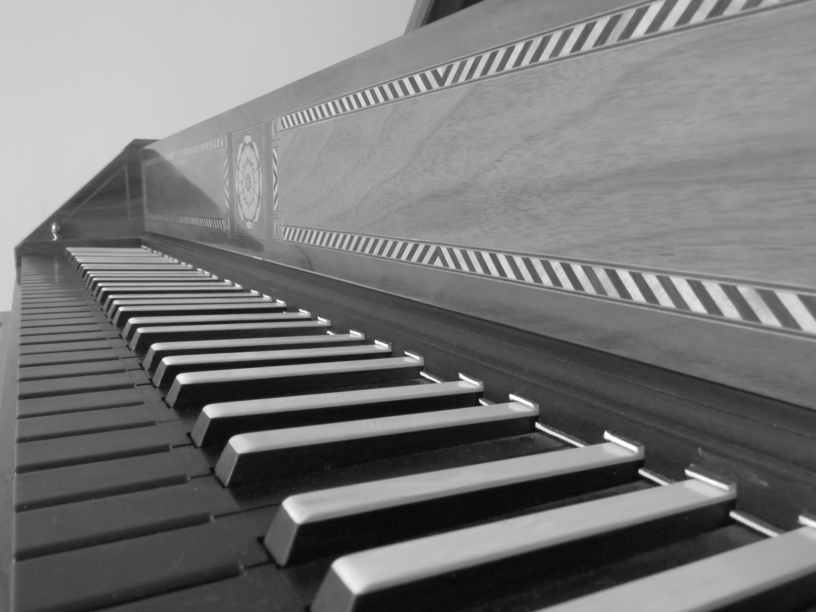
Our awareness of this historical variety in instrument design (which is not always reflected by recent fortepiano copies) was a background motivation for our project. I [Helena] play the so-called ‘modern’ piano and the fortepiano, and a considerable proportion of the works that I play on both instruments has been composed in the last three decades. We [Helena and Joaquim] have often created, or participated in, projects connected to experimentation, linking technology and performance, and the choice of the fortepiano as a resource is thus connected to our former and present activities.
My [Helena’s] copy of a 5-and-half octave 1805 Walter & Sohn fortepiano has two knee-levers: sustaining and moderator. Its features, therefore, are close to the sound effects available on a ‘modern’ piano, although the moderator effects entails a change of timbre far more striking than the standard una corda of modern pianos. The prominent timbre of the moderator, which stands out as a distinct sonic affordance of the instrument, is one of the features that allows for the creation of effects (including when used in association with the sustaining knee-lever) that stand out in contrast with the ‘modern’ piano.
Our awareness of the varied range of historical effects spurred a research question, which was the focus of our first publication on this subject:[11] considering the limited range of sound-altering devices available in modern copies of fortepianos (such as Helena’s), how could we conceive and apply experimental alternatives? Having decided, given our own artistic profiles, that we would explore digital resources, a second question arose: how would the digitally-based alterations modify instrumental perception and lead to the creation of alternative performing strategies, in association with improvisatory practices and sound synthesis?
The ideological and musicological implications arising from the embodiment and use of historical information in performance will not be addressed here; the debate on historically-informed performance is well documented,[12] and its caveats and counsels for composition have no relevant implications for this specific research project.
Our aim was to develop a way of expanding the fortepiano’s features through digital resources, using techniques of sound design and programming, in order to study how these might interact with the performing and improvising processes, and to discuss their applicability and impact for performance on this specific historical instrument.
Our research plan encompassed five interconnected and chronologically ordered tasks:
-
mapping and characterizing the main Veränderungen devices and effects associated with the fortepiano, taking a literature and recording review as our point of departure;
-
undertaking sound capture with piezoelectric microphones and other electronic devices, in order to test techniques of sound synthesis, sampling and programming with Max/MSP;
-
testing the applications created in the previous task;
-
developing creative studio work, involving free improvisation that incorporated the applications that had been tested;
-
analysing and discussing the relevance of the applications developed for the project, taking into account the artistic outputs.
Part of this research was undertaken at our home studio (2018-19), complemented by a more intense research residency held at the Orpheus Institute in Ghent in 2018 that arose from an invitation for Helena to work there for two weeks as an invited researcher.
Expanding the fortepiano
back to top
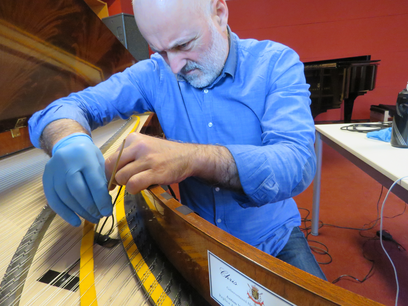
Engaging with staple repertoire through the creation of digital effects comparable to historical stops was one of our initial ideas, but we rapidly understood the artistic limitations of merely adding historically-inspired effects to extant repertoire (regardless of its time of composition). We discussed the possibility of emulating some of the effects associated with historical stops, whether involving specific types of resonance, timbral modifications or percussive effects. This approach was rejected on two counts: on the one hand, it would not allow for an effective integration or expansion of effects, as it was based on addition or superposition; on the other hand, it did not address our research questions or aims effectively, and seemed, at its crudest, to approach parody.
We decided to explore another path, built on our own understanding of Veränderungen as a repository of instrumental affordances, and of related practices and techniques. We focused on a possible systematization of these affordances as an extension of the instrument’s basic instrumentality, which, “taken as a specific quality of musical instruments, may serve as a starting point for observations from the most diverse backgrounds that seek to comprehend how exactly our interaction with and our conception of musical instruments has changed through digital technology”.[13] Thus, we felt the need to distinguish between what we labelled in our work diaries as ‘effects’ and ‘behaviours’.

‘Effects’ referred to selected digital effects, namely those from the set of effects offered by Max for Live; the term was confined to the use of sound effects that are superimposed upon pre-composed repertoire. ‘Behaviours’, on the other hand, referred to programmed actions, involving sound capture as a basis for pre-programmed Max/Msp patches that engaged directly with the contents. The distinction between effects and behaviours, while useful as an initial work guideline, proved less pertinent as an operational concept throughout, as a close interaction between these two perspectives eventually became inevitable. Whilst the exploration of effects was maintained as a work task, the emulation of historical stops was discarded altogether in favour of work directed at non-referential digital effects and real-time sound synthesis, on the assumption that this would lead to an increased epistemic and technological complexity and, ultimately, to a shared outlook on these applied procedures.
Our initial setup included two Røde NT5 microphones, a Roland Rubix 22 soundboard, an M-audio Code 25 midi controller, iRig pads, and Roland Cube Monitor loudspeakers; as software, we used Mira for iPad, Ableton Live, Max/MSP/Jitter, Max for Live, and Native Instruments Reaktor. At this point, we were focusing on developing an application that could engage dialogically with improvised practices, and that could be controlled from the fortepiano keyboard.

The result of our initial work sessions was Xpanded Fortepiano, a Max MSP patch that we tested at our home studio for a few months (described in Marinho and Branco).[14] The patch records music sections chosen and played by the performer during the course of live performance; the moment and duration of the recordings can be set either by the performer or by a collaborating partner at the computer. The patch then reads audio slices, chosen randomly with regard to their extension and location in time. At the core of the patch is an object called ‘groove’, which has the capability of reading audio samples from any point, changing pitch and speed, whether pre-programmed or randomly; following a Cagean approach, we chose the random mode. The performer or a collaborating partner can select some of the characteristics of the audio samples, namely: 1) the range of duration of the audio samples, setting its highest and lowest range in milliseconds, which is then randomly chosen by the patch; 2) the range of repetitions, which is also set by selecting its highest and lowest number, for example, from 1 to 8, which is also randomly chosen by the patch.
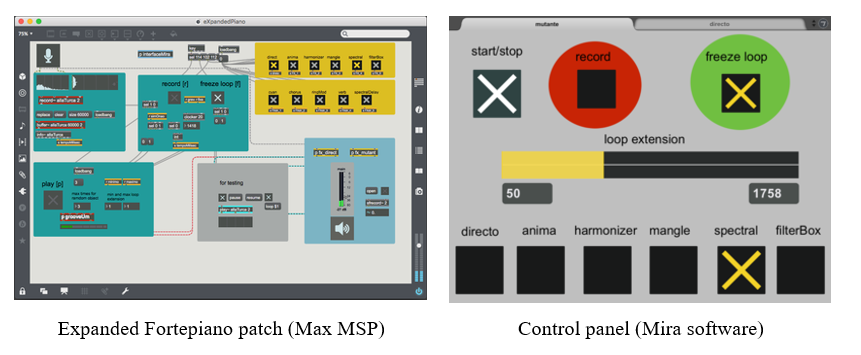
The resulting altered audio excerpts are played back, and the audio signal of the samples passes through one or more effects processors; the effects we used so far were selected from the software package Max for Live. The patch then applies these pre-selected effects to these materials as they are played back, and they become the basis for a dialogue with the performer that can take place in the context of performances of musical texts, improvisations or a combination of both. In order to facilitate the use of this application, a graphic control panel for iPad was designed, using Mira software; through this panel, the performer can start and stop recording, freeze and set the extension of selected loops, and select one, or more, from a set of five effects. This control panel allowed me [Helena] to use the application autonomously, but presented some problems, namely the reduced number of available effects (which limited performing strategies) and the time required to engage the recording and effects controls (which created ineffective pauses).
During our work residency at the Orpheus Institute, other applications were created. We decided to discard the designation Xpanded Fortepiano, and developed and tested four other patches. One of the new patches, Wandering, maintained most of the characteristics of the original Xpanded Fortepiano patch, as described above. Our setup involved a different fortepiano, a copy of a 1795 Walter fortepiano, built by Chris Maene, and some of the hardware was changed. In order to prevent the feedback problems that we had to address in our first work sessions, we decided to use four piezo sensors, which gave the added advantage of being able to record specific frequency spectra according to their placement. We also used a Roland Rubix 22 soundboard, a Novation Nocturn controller (a knob based-midi controller), and two Bose SoundLink Revolve+ speakers, which were lighter, more practical for positioning and with 360° sound; as software, we used Mira for iPad, Max/MSP/Jitter, and Max for Live.

justFX patch (MaxMSP)
justFX was the Max patch we designed and used for our initial work at Orpheus; as its name implied, it focused exclusively on the ‘effects’ perspective. The audio signal was modified by sound effects from Max for Live, and Joaquim developed another interface in Mira software that could be used by a collaborator or the performer. Pre-existing repertoire provided relevant material for the initial sessions: Mozart’s Alla Turca, or a prelude by Czerny from the The Art of Preluding, Op. 300 (Prelude no. 99): in this case, we used a digital effect to evoke the bassoon stop in selected sections, especially in the lower register.
Czerny. Prelude no. 99, from the The Art of Preluding, Op. 300
John Cage’s In a Landscape proved particularly interesting to work on; composed for piano or harp, its aptness for the fortepiano is also remarkable. Cage’s Sonatas and Interludes were on our mind while trying out specific effects; we could thus avoid inserting physical objects to ‘prepare’ the fortepiano.
We also used this patch to work on a piece by the Portuguese composer Vasco Negreiros, Aqua (“Water”), from a series of four pieces for piano or fortepiano, combining the result with a video that had being designed specifically for it. In this case, we were trying to address the theme of the work, an integration of fortepiano and water-like sound, aiming for a sonority that could subtly enhance the video created by Nuno Barbosa for this piece.
Vasco Negreiros (music) and Nuno Barbosa (video). “Aqua” from Quattuor Elementa
The patches described below focused predominantly on the ‘behaviours’ perspective, and could be associated either with extant repertoire or with improvisation.

Octavia’s Threads patch
The patch called Octavia’s Threads was designed for a piece with the same title, composed by Jônatas Manzolli for me [Helena] in 2014. It was inspired by Italo Calvino’s book Invisible Cities, in particular its description of Octavia, a city built upon a spider web of ropes and chains, suspended in the air between precipices. The patch holds pitches selected in real-time, controlled by a collaborator-musician through an iPad interface. Duration and volume are also controlled in real-time through an object called vb.stretch~ (designed by Volker Böhm), integrated into the patch, from 1-second-long samples; the sound is stretched and, therefore, the timbre changes.
Octavia’s threads by Jônatas Manzolli + patch Octavia

Prach’s Patch
Prach’s Patch was designed following conversations with the composer Prach Boondiskulchok while we were at the Orpheus Institute, and is based on some of the ideas that we discussed. This patch works with selected predefined frequencies; these frequencies, up to 13, were chosen from a harmonic series or from other types of pitches, according to our predefined options. These frequencies were obtained through subtractive synthesis applied to a wide-range cluster recorded at the fortepiano. Subtractive synthesis was applied through two filters: bandpass and resonator. As with Octavia’s Threads, this patch can be controlled by a musician-collaborator or by the performer at the fortepiano.

Wandering patch (improved version of the Xpanded Fortepiano patch)
Finally, the patch Wandering was an optimization of the Xpanded Fortepiano patch, solving some of the problems found in its earlier version. We tested and added more effects (reaching a total of 17 effects, from Max and Max for Live) and created a more user-friendly interface.

New patch interface
Free improvisation with the Wandering patch
Trialogue: free improvisation with the Wandering patch
Wandering: free improvisation with the Wandering patch
Some concluding remarks
back to top

These work sessions have identified some issues that will need to be addressed in the future, namely: varying the choice of effects through synthesis; creating tools that can further optimize either the performer’s autonomy or the collaborative work with the people involved in the performance, whether the pianist or another musician at the computer, who, ultimately, has an essential and creative role in the process; and, finally, identifying patterns of improvisation that can engage more effectively (technically and artistically), and with fewer pauses, with the task of setting loops.
We believe that historical instruments are a relevant point of departure for experimental creation, but have observed that the mere historical re-construction of effects through digital procedures presents obvious aesthetic limitations. We hope that our work may contribute towards proposing paths for experimentation with historical instruments through the mediation of electronic interfaces and digital sound objects. We have also observed that some of our apps have a strong potential for the development of collaborative work procedures; they can ultimately become accessible work tools for performers and composers (even those composers who are not into electronic music) and, through interfaces like laptops or mobile phones, can enhance engagement with audiences.
But we are also aware of the potential problems: in this process, and applying these methods, will we lose the identity of the instrument? Should we return to the study of the fortepiano’s own idiosyncrasies – for instance, exploring its sounds through the use of piezo microphones and their specific placement so as to capture the fortepiano’s timbral characteristics? Or should we proceed even further towards the deconstruction of the standard perception of the sound of historical keyboard instruments? Such an approach would echo Bob Gilmore’s reference to a post-experimentalist outlook,[15] defined in contrast to the historical perspective on experimentation, which, to us, suggests that experimentation involving new instrumental affordances can redefine the roles and perception of historical instruments and place them within a post-instrumental and post-experimentation framework. A similar outlook has been developed by researchers such as Håkon Stene,[16] for instance, who refers to a post-instrumental paradigm – one that takes its point of departure from the study of unconventional and experimental instrumental affordances in percussion.
We have no answers to these questions for now, but will keep searching for the ultimate (?) app: pianist-in-a-box.
This research was funded by the project “Experimentation in music in Portuguese culture: History, contexts and practices in the 20th and 21st centuries”, co-funded by the European Union through the Operational Programme Competitiveness and Internationalization, in its ERDF component, and by national funds through the Portuguese Foundation for Science and Technology. Further development of the applications was carried out during a residency funded by a visiting researcher grant of the Orpheus Institute.
The authors would like to thank Jônatas Manzolli, Vasco Negreiros and Nuno Barbosa for granting permission to include their works in this publication.
-
The instrument’s designation, ‘fortepiano’ or ‘pianoforte’, currently used in some languages (notably English) to distinguish pianos manufactured before the mid-19th century from current models, is not validated by research. Nevertheless, it would be nearly impossible to propose a more adequate terminology, considering the variety of models in this instrumental genre, and the fact that the ‘modern’ piano itself is, essentially, a copy of late-19th century designs. ↩︎
-
Michael Cole, The Pianoforte in the Classical Era (Oxford: Clarendon Press, 1998). ↩︎
-
Dieter Hildebrandt, A Social History of the Piano (New York: George Braziller, 1988), p. 148. ↩︎
-
Cit. by Michael Latcham, ‘Franz Jakob Spath and the Tangentenflügel, an Eighteenth-Century Tradition’, The Galpin Society Journal, 57.May (2004), 150–70 (p. 161). ↩︎
-
Cit. by David Rowland, ‘Early Pianoforte Pedalling: The Evidence of the Earliest Printed Markings’, Early Music, 13.1 (1985), 5–17 (p. 5) \ https://doi.org/10.1093/earlyj/13.1.5. ↩︎
-
Ibidem. ↩︎
-
Rebecca Cypess, ‘Timbre, Expression, and Combination Keyboard Instruments: Milchmeyer’s Art of Veränderung’, Keyboard Perspectives, 8 (2015), 43–69. ↩︎
-
Cf., for instance, Tilman Skowroneck, ‘Beethoven’s Erard Piano: Its Influence on His Compositions and on Viennese Fortepiano Building’, Early Music, XXX.4 (2002), 523–39 \ https://doi.org/10.1093/em/xxx.4.523. ↩︎
-
M. Latcham, ‘Swirling from One Level of the Affects to Another: The Expressive Clavier in Mozart’s Time’, Early Music, 30.4 (2002), 502–20 (p. 515) \ https://doi.org/10.1093/em/xxx.4.502. ↩︎
-
Tom Beghin, Inside the Hearing Machine: Beethoven on His Broadwood (Mechelen: Evil Penguin Records Classic, 2017). ↩︎
-
Helena Marinho and Joaquim Branco, ‘The Expanded Fortepiano’, in Synchresis Audiovision Tales, ed. by Isabel Soveral and Fátima Pombo (Aveiro: University of Aveiro, 2019), pp. 207–2012. ↩︎
-
John Butt, Playing with History: The Historical Approach to Musical Performance (Cambridge: Cambridge University Press, 2002). ↩︎
-
Musical Instruments in the 21st Century: Identities, Configurations, Practices, ed. by Till Bovermann and others (Singapore: Springer, 2017). ↩︎
-
Marinho and Branco. ↩︎
-
Bob Gilmore, ‘Five Maps of the Experimental World’, in Artistic Experimentation in Music: An Anthology, ed. by Darla Crispin and Bob Gilmore (Leuven: Leuven University Press, 2014), pp. 23–29. ↩︎
-
Håkon Stene, ‘This Is Not a Drum: Towards a Post-Instrumental Practice’ (Norwegian Academy of Music, 2014). ↩︎